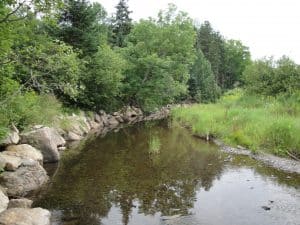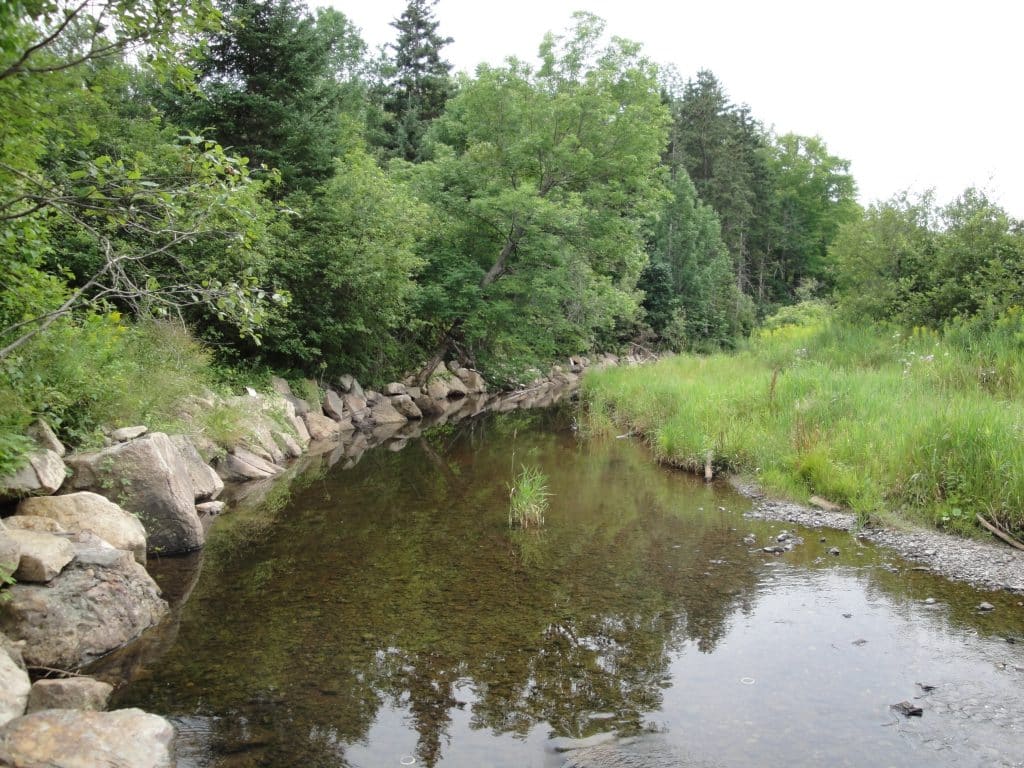Land bordering streams, rivers, wetlands, ponds, and lakes are known as riparian areas and provide a number of benefits to ecosystems and society. Riparian areas serve as a transitional zone from aquatic to terrestrial habitats and characteristics. With increasing loss of riparian areas, communities are experiencing reduced water quality, reduced wildlife and fish populations, property damage, bank erosion, soil damage from wind and sunlight, reduced water storage capacity, and shallow stream widening from sediment deposition. Riparian areas are being degraded and lost altogether from development and urbanization, damming, agriculture, and a number of other land use practices. With increasing population growth rates and development needs, why should preserving these areas be a priority?
Flood Control Benefits: Riparian zones allow flood waters to be spread horizontally across the channel or waterbody without negative effects like sediment deposition or nutrient loading. These areas also provide water detention and storage while allowing groundwater infiltration to filter and slowly return floodwaters to the surface water. By naturally controlling and absorbing flood waters, riparian areas reduce the force, height, speed, and volume of flood waters. These benefits help to mitigate and prevent damage to developed areas downstream of the waterbody.
Water Temperature Benefits: Riparian zones help prevent or reduce water temperature fluctuations and extremes. Riparian zones contain tall, woody vegetation that produces a canopy able to reduce the amount of solar radiation that reaches the surface water. Less radiation means cooler temperatures. This increases oxygen levels and nutrient bioavailability.
Erosion Benefits: Riparian vegetation dissipates water energy through its deep roots. These roots help to hold soil in place to stabilize the banks and prevent excessive soil loss. Allowing flood waters to spread out and infiltrate the groundwater table in areas with this type of vegetation will reduce erosion levels and help protect properties from damages from flooding or erosion.
Water Filtration Be nefits: Riparian vegetation intercepts, absorbs, and/or filters nutrients, sediment, pesticides, and fertilizers from runoff before they are inputted into the surface water. Riparian zones are able to capture up to 90% of sediments, 65% of nitrogen, and 30% of phosphorus. These plants also absorb dissolved nutrients, further combating eutrophication and excess nutrient levels. Water with fewer pollutants will require less treatment and help reduce associated emissions from water treatment plants.
nefits: Riparian vegetation intercepts, absorbs, and/or filters nutrients, sediment, pesticides, and fertilizers from runoff before they are inputted into the surface water. Riparian zones are able to capture up to 90% of sediments, 65% of nitrogen, and 30% of phosphorus. These plants also absorb dissolved nutrients, further combating eutrophication and excess nutrient levels. Water with fewer pollutants will require less treatment and help reduce associated emissions from water treatment plants.
Habitat Benefits: Riparian zones can account for up to 99% of energy inputs into waterbodies. This helps provide food and nutrients for in-stream and nearby plants and animals. Riparian zones are also excellent habitats for migratory birds, mammals, reptiles, and insects. Large woody debris from riparian areas also serves as in-stream habitat for fish. Riparian areas serve as high forage areas and allow wind break and thermal cover. They also form corridors to connect to other habitats, enabling safe migration for animals like deer and rabbits.
Recreational Benefits: Protected green spaces serve as excellent places for a number of recreational activities. Riparian areas in particular serve as great spaces for hunting, fishing, canoeing, bird-watching, or hiking. Each of these activities produces regional economic inputs through travel, equipment, outfitting, food, and lodging.
Economic Benefits: Riparian areas are associated with higher property values due to their beautification, privacy, and flooding control benefits. Areas near protected riparian areas often see a 6% property value increase. Natural, protected riparian areas also provide resistance against noxious weeds and invasive species.
Riparian zones are important for wildlife, plant, and aquatic species as well as human society. Without these areas, important habitats and species would be lost, and flooding control and water quality concerns would increase dramatically. With ever-increasing development pressures and population growth rates, the best time to start protecting riparian areas is now.

